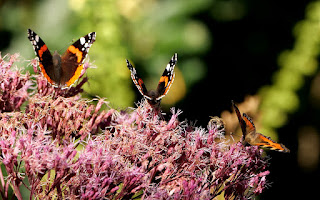~~
 The Leica-Lumix zooms have quite close focusing at full zoom so take useful close-ups. [Not macro!]
The Leica-Lumix zooms have quite close focusing at full zoom so take useful close-ups. [Not macro!]A patch of the flower garden was still in bright sunshine after lunch. So I snapped away at the butterflies and bees before the trees threw their shadows over them.
The Leica 50-200 with 1.4x TC was used on the G9 at 280mm. Finding focus was often a struggle at close range. I was using pinpoint and AF but it would often completely ignore the foreground. Manual focus was too confusing with a greatly enlarged image overlay.
 There was no shortage of butterflies but they weren't there to pose for me. Nor did they stay still for very long. I had lots of images but most were not critically sharp, not displaying their wings to full effect or falling off the edge of the frame.
There was no shortage of butterflies but they weren't there to pose for me. Nor did they stay still for very long. I had lots of images but most were not critically sharp, not displaying their wings to full effect or falling off the edge of the frame.
Yet again I had to crop hard in PhotoFiltre to increase the scale of the subject within the image frame. Resizing [smaller] was also necessary for the blog.
Red Admiral. [Left] Small [?] Tortoiseshell [Above] There were several sizes of almost identical butterflies but I wasn't carrying a vernier caliper.
Bees are too busy to hover over them in the hope of a useful pose. So I just kept snapping away. Then had to discard almost all of my images as worthless.
Butterflies come in threes? There were actually seven on the same flower head at the same time.
Catching numerous examples simultaneously is almost impossible when the depth of field is reduce by proximity. This lucky 'snap' was deliberately taken from further away.
Lots of valuable lessons learned today. Not least that 400mm would be even more useful for reaching insects in very deep flower beds.
~~

